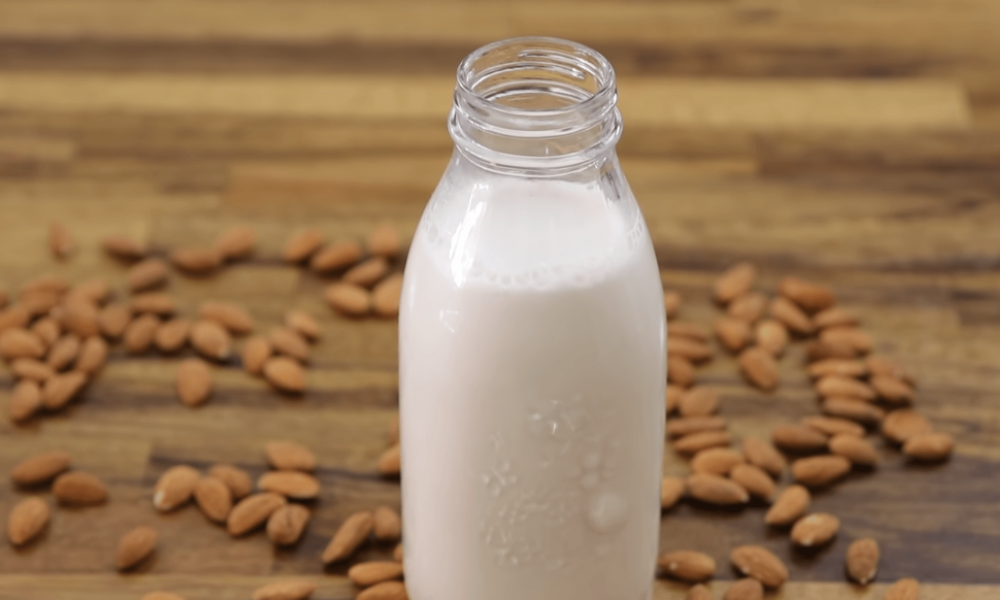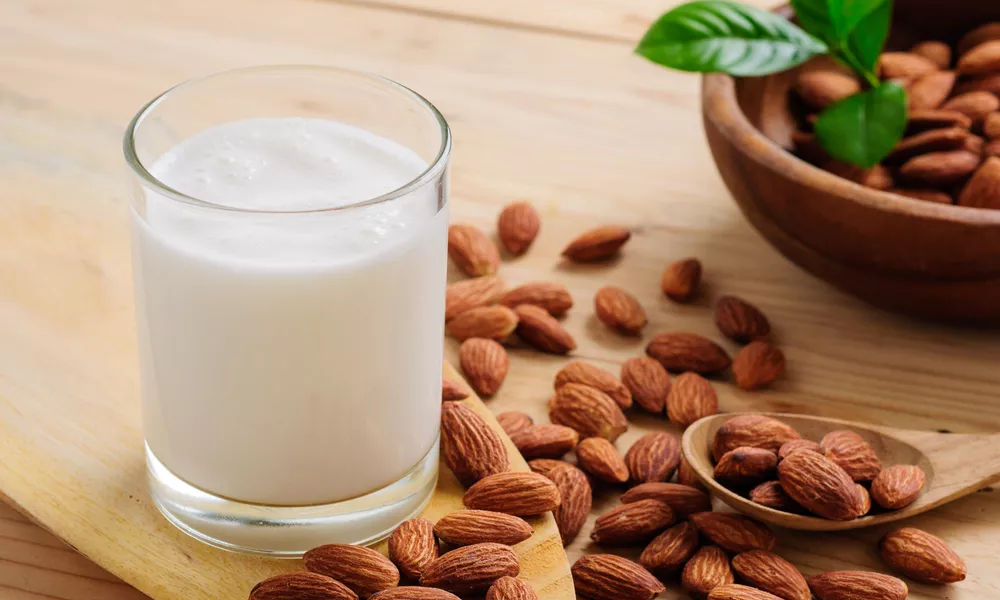Almond milk is a type of plant milk made from almonds. It is a popular lactose-free alternative to cow’s milk for those who are vegan or follow a plant-based diet. Almond milk is made by blending ground almonds with water, and it can be flavored and sweetened with various ingredients.
It is high in nutrients, such as calcium and vitamin E, and low in calories and fat compared to cow’s milk. Almond milk has a nutty, creamy flavor and can be used in smoothies, cereals, and baked goods. It’s also a popular ingredient in vegan cheese and yogurt.
How is Almond Milk Made?
Almond milk is created by combining almonds with water, then filtering the resulting liquid to eliminate the solids. Additionally, you can prepare it by mixing water with almond butter.
Its flavor is nice and nutty, and its texture is creamy, like that of ordinary milk. Due to this, it is a well-liked option for vegans and others who are intolerant or allergic to dairy.
Almond milk is typically located in the health food department of most stores. Making it at home is also really simple. There are numerous kinds and tastes of commercial almond milk available. It is advisable to use almond milk without added sugar for health reasons.
The majority of brands additionally contain added protein, vitamins, or minerals. If you don’t consume dairy, you might gain from picking calcium-enriched items.
There are a few straightforward steps you must follow when making your almond milk. To ensure that your almonds are devoid of antinutrients, you must first soak them in water for an entire night.
The soaked almonds must then be blended, the solids must be strained out, and sweetness must be added to the liquid. Finally, there are a variety of uses for almond milk.
Steps that you Must Take to Make Almond Milk
Almonds Should be Soaked Overnight to Eliminate Antinutrients
It is normal to soak almonds in water for an entire night to get rid of antinutrients and improve flavor and texture. Additionally, it enhances their ability to absorb. Almonds can be preserved their nutritional value by simply soaking them.
Antinutrients that prevent the absorption of vitamins and minerals can be eliminated through soaking. Additionally, it lowers fat and cholesterol levels.
The digestive enzymes that break down food are also improved by it. Almonds are now easier to chew and digest as a result. Additionally, it is a fantastic strategy to increase nutrient consumption.
Protein, magnesium, fiber, and omega-3 fatty acids are all abundant in almonds. These nutrients aid in maintaining your satiety and avoiding constipation. They are also a good source of L-carnitine, an amino acid that encourages the formation of brain cells.
Blend
You’ve arrived at the right site if you’re seeking the finest method to create almond milk. The process is quite simple, and the outcome is fantastic!
Almonds are first soaked in water for the whole night. This ensures that the components are smooth and helps to eliminate the skin.
After soaking, you should give them a thorough washing before adding two cups of water to a blender or food processor. You can also get the most creamy almond milk possible by doing this.
You may sip a thick and creamy almond milk after a few minutes of blending! When you’re cooking, baking, or want something a little sweeter, it’s a terrific beverage to keep on hand.
Strain
Soak nuts to make delicious nut milk. Many medical professionals assert that soaking milk increases its nutrients by activating enzymes and extracting oils. The milk will become creamy and wonderful after soaking the almonds for a few hours.
The most vital step in creating almond milk is soaking your nuts. The natural oil and water content can be extracted by soaking them overnight, producing a delicious beverage.
After soaking your nuts, you have two options: either put them in the fridge for up to two days or use a blender to make a slushy drink. To get the most out of the soaked almonds, it is ideal for mixing them.
Almond milk can also be strained using a fine mesh strainer. The milk can be used for baking, as the foundation for a smoothie, or to produce homemade almond flour after it has been strained.
Boost Sweetness
An excellent beverage for the morning is almond milk. It is high in calcium and low in calories. Also, making it is really simple. It can be used in hot beverages, baked items, and as a dairy-free substitute for cow’s milk.
You may make almond milk by incorporating your preferred sweetener. To your almond milk, you can add agave nectar, honey, or maple syrup. For added taste, you can choose to add vanilla extract.
Two ingredients—raw almonds and water—are required to produce almond milk at home. They can be combined in a blender for two minutes, then strained using cheesecloth or a nut bag. Cocoa powder can be added to almond milk to make it chocolate-flavored.
What are the Uses of Almond Milk?
Almond milk is a creamy, nutty beverage that tastes fantastic on its own and when combined with other foods. It’s a great substitute for traditional dairy milk. And preparing it at home is simple.
Almond milk offers the convenience of almond consumption in addition to some potential health advantages. It has a lot of calcium and vitamin D, which can strengthen your bones and immune system. Almond milk contains vitamin E, which also helps shield your body from free radicals.
The ability of almond milk to decrease blood pressure is another advantage. Heart sufferers will notably benefit from this. Additionally, it’s a wise choice for anyone with low energy levels or lactose sensitivity.
You can use almond milk to prepare a range of different dishes in addition to drinking it. It can be included in smoothies, oatmeal, cereals, and other dishes.
Is it Nutritious?
Although enhanced goods are close to being as nutrient-dense as cow’s milk, almond milk is not even close. They typically have extra calcium, protein, and vitamin D, which makes them more nutritionally comparable to ordinary milk. Almond milk is naturally abundant in a number of vitamins and minerals, particularly vitamin E.
Almond milk is not a viable milk substitute for infants because it is deficient in several nutrients.
Is it Low in Calories?
Commercial almond milk is a low-calorie beverage even though almonds are high in calories and 50% fat.
This implies that consuming large amounts of it won’t result in weight gain. In relation to its calorie level, it is also rich in several nutrients.
Almond milk is diluted with water by its manufacturers to make its 1% fat level more comparable to that of low-fat milk.
A cup of almond milk has only 39 calories, which is less than half of what a cup of skim milk has in terms of calories.
But not all almond milk is created equal. Depending on how many almonds are in each cup, homemade almond milk and some brands may have substantially higher calorie counts.
Additionally, for the greatest health benefits, consumers should avoid goods that have added sugar.
Does it Raise Blood Sugar?
There is a lot of almond milk on the market that is highly sweetened. Contrarily, sugar-free almond milk has less than 2%, or 3.43 g, of carbohydrates per cup, making it a low-carb beverage.
A cup of low-fat cow’s milk has 12 g of carbohydrates or 5% of its total carbohydrate content. In comparison to its carbohydrate level, almond milk is also heavy in fat and protein. This means that it is excellent for both those on a low-carb diet and those with diabetes because it prevents increased blood sugar levels.
Is it Dairy Free?
Almond milk is an excellent choice for vegans, those with lactose intolerance, and people who are allergic to milk because it doesn’t include any cow’s milk or other animal products.
Many people can’t fully digest milk sugar (lactose) due to lactose intolerance. Undigested lactose in these people travels to the colon, fermented by the colon bacteria, causing excessive gas, bloating, diarrhea, and other unpleasant symptoms.
Almond milk is a great milk substitute for those who are lactose intolerant because it is dairy-free and completely lactose-free.
How are They Good for Bones?
The best dietary source of calcium is dairy food. Almonds, on the other hand, are a bad provider of this nutrient.
Producers frequently add calcium to almond milk to resemble traditional milk. For instance, depending on the type and brand, a cup of commercial almond milk may contain 37% or more of your daily requirements.
In contrast, depending on the type and brand of milk, a cup of cow’s milk may provide about 23% of the daily recommended calcium intake.
As a result, for those who don’t consume dairy products, such as vegans, lactose intolerant individuals, and people who are allergic to milk, enhanced almond milk is a great calcium supply.
Calcium is necessary for the development and maintenance of bones. Because of this, consuming enough calcium lowers the risk of osteoporosis, a disorder linked to brittle bones and fractures.
Conclusion
It is simple to understand why this plant-based milk replacement has swiftly become the most well-liked non-dairy milk substitute thanks to higher concentrations of essential nutrients and fewer calories. The taste is exceptional, too!
Without any flavorings, fillers, or preservatives, it is prepared with such superior freshness. It is really great, especially for someone like myself who doesn’t naturally gravitate to milk. It doesn’t even leave a characteristic milky aftertaste, making it easy on the stomach.

